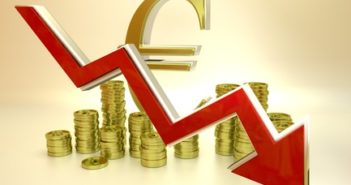- Euro-zone July inflation and second-quarter GDP are set to show a slowdown.
- The European Central Bank will be using this data to construct its monetary stimulus package.
- The figures due out hours before the critical Fed meeting may weaken the euro.
“The economic outlook is getting worse and worse” – said Mario Draghi, President of the European Central Bank less than one week before fresh top-tier data is due out from the euro area.
The data is due out on Wednesday, July 31st, at 9:00 GMT.
Slowing down

Starting with the big-picture data, economists expect GDP growth to have halved in the second quarter – 0.2% against 0.4% in the first quarter. Annual expansion carries expectations for a decline from 1.2% to 1%. These forecasts are in line with monthly industrial output, retail sales figures, and other data from the continent’s economies. Moreover, preliminary GDP from France – the currency bloc’s second-largest economy – has disappointed with 0.2% against 0.3% expected.
There are various reasons for this deceleration. Trade tensions between the US and China have lowered global growth and have mostly hurt the most important sector in the largest economy – German industry. Troubles are also brewing in the third-largest economy – Italy. Rome has clashed with the EU in Brussels over its budget. The looming fear of a hard Brexit also plays an adverse role.
Moving onto inflation – the ECB’s single mandate, the same depressing expectations are intact. The Consumer Price Index (CPI) is forecast to slip to 1.1% year on year in the preliminary read for July against 1.3% in June. Weaker headline inflation can be blamed on lower energy prices. Nevertheless, investors also foresee moderation in Core CPI – from 1.1% in June to 1.0% in July. Underlying inflation has been clinging to around 1% for many months. Preliminary German and Spanish inflation figures have not altered expectations for the 19-country EMU.
Core prices have been unable to budge despite rising wages and falling unemployment. Looking at the economic calendar, we are seeing that the jobless rate is set to remain unchanged at 7.5% – a low and encouraging level for Europe. Nevertheless, the bustling labor market limited impact on the euro’s price action.
EUR/USD positioning ahead of the Fed
EUR/USD has been grinding its way higher early in the week, enjoying the distraction in markets. UK PM Boris Johnson’s hard Brexit plans have sent the pound plummeting. Anticipation for the Fed decision – due out seven hours after the EZ data dump – have also allowed the currency pair to gradually recover.
Underwhelming euro-zone GDP and inflation figures may bring this quiet recovery to an end – even if the figures come out as expected. They will serve as a reminder that the ECB is waiting around the corner to act. Not only is Draghi’s outlook getting worse – but also the hard economic evidence. The bank will remain on track to slash rates.
In case, the figures – especially inflation ones – slip below expectations, the Frankfurt-based institution will have a greater urge to introduce a broad stimulus package in September. This may include a new bond-buying scheme in addition to reducing interest rates.
There is always room for an upside surprise, especially in GDP, which tends to be somewhat more volatile. If growth comes out at 0.3%, the euro may extend its gains amid expectations for a more moderate bundle of measures from the ECB.
It is important to note that price action may remain limited given the upcoming Fed decision. The world’s most powerful central bank is set to cut interest rates for the first time since the crisis. Nevertheless, Chair Fed and his colleagues will likely refrain from opening the door to a long cycle of rate reductions as recent US data has been satisfactory. For comparison, US core CPI stands at 2.1% as of June while the quarterly growth rate was around 0.5% in the second quarter.
Conclusion
Euro-zone growth and inflation figures are set to show a slowdown and add to the ECB’s case for announcing monetary stimulus in September. The data will likely weigh on the euro and weaken its position ahead of the all-important Fed decision later that day. A beat would be needed to keep EUR/USD stable – and that seems unlikely given the most recent indicators.
Get the 5 most predictable currency pairs
